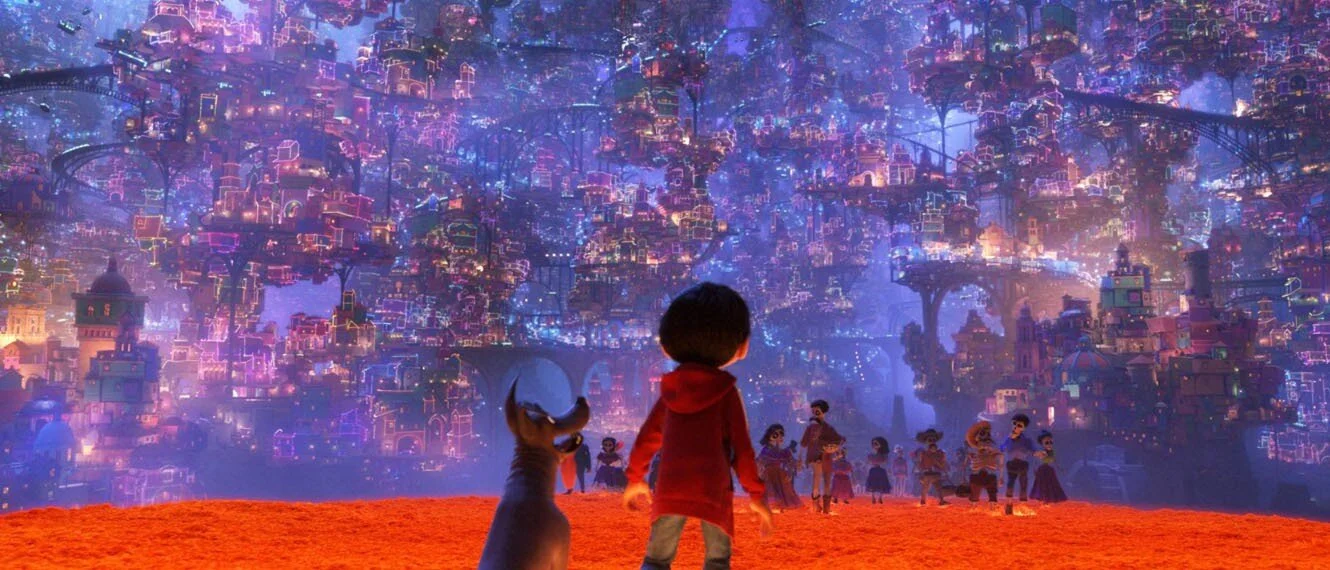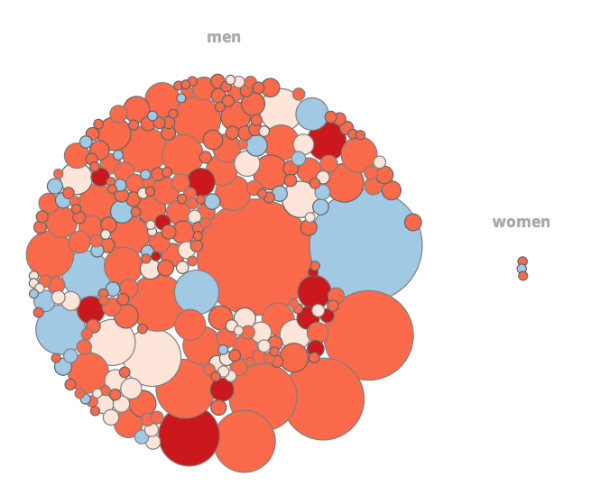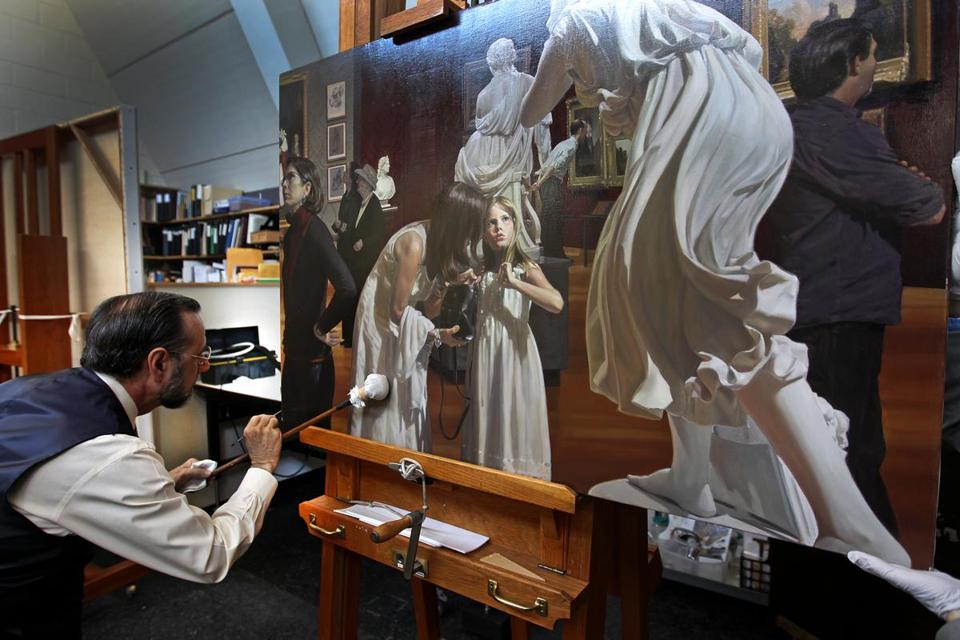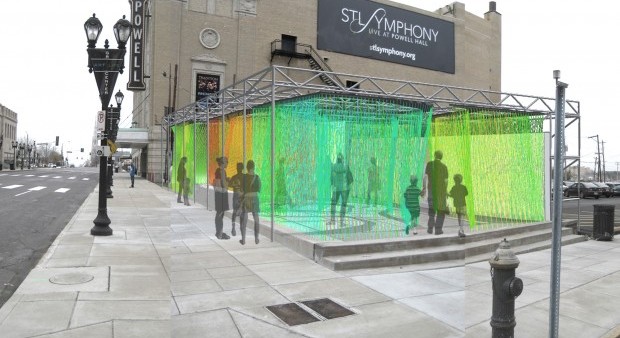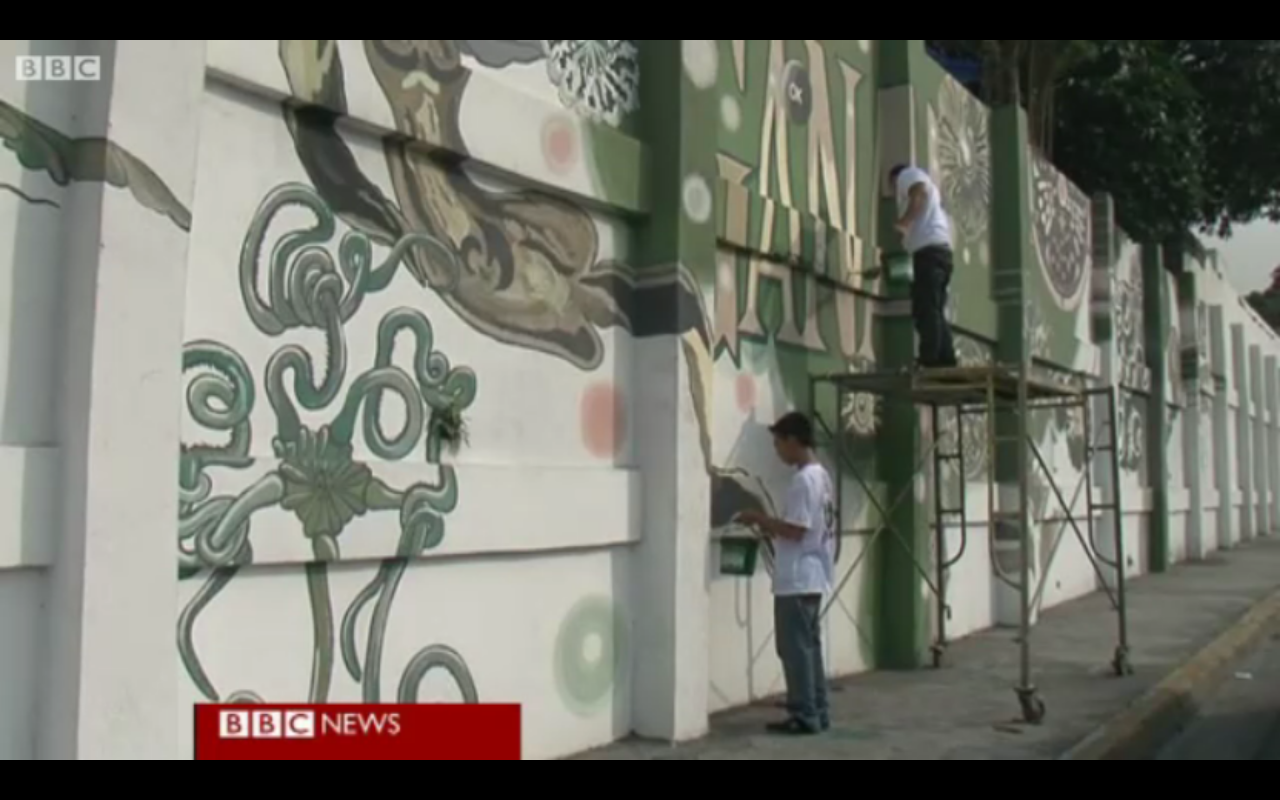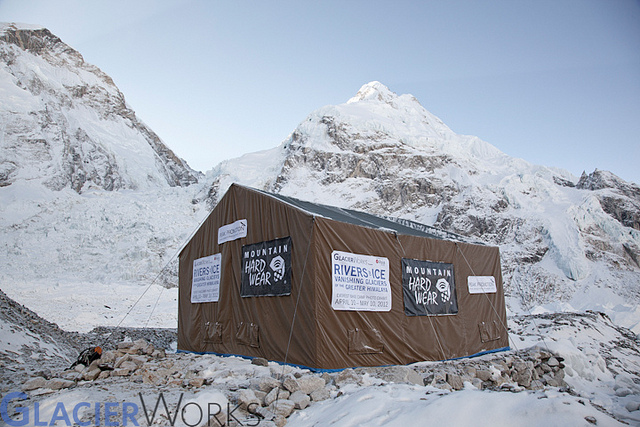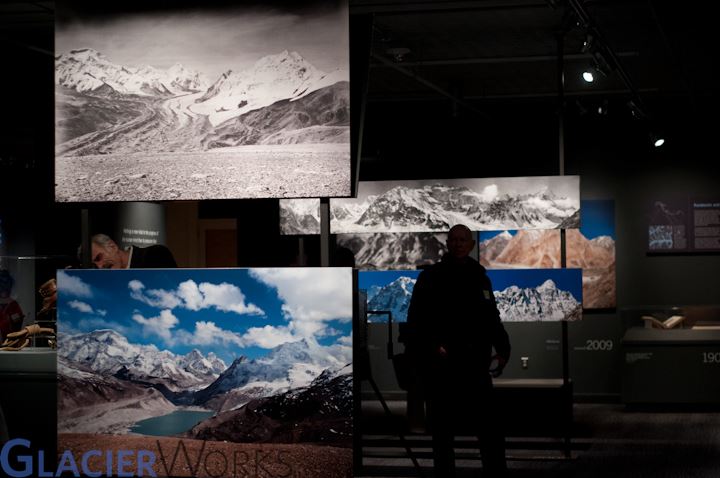This month, it’s hard to find a headline that doesn’t mention “AI.” For artists and arts managers, it can now be integrated in every aspect of our work - from creation, to promotion, and general administration. Even your iPhone may soon have AI features integrating messages, calendar, photos, and other personal content. In both music and visual spaces, artists are finding ways to push back on unethical use – while some take legal action, others call for change through the spaces they share their work.
TBT: Art and AI
In late August, Jason Allen's AI-generated artwork "Théâtre D'opéra Spatial" took first place in the digital category at the Colorado State Fair. One critic called it "the death of artistry." But others, like Shelly Palmer, say if he crossed a line, "we’ve been walking up to the edge for decades." Allen himself believes AI-generated art will eventually become its own category.
Today, we're looking back at some of the ways AI has been incorporated into the visual arts realm.
Art Restoration Technologies: Renewing Artwork in the 21st Century
In the visual arts, there is no guarantee that work will be preserved for any time after it has been created. While physical pieces are certainly more permanent that performances, all works are subject to deterioration and destruction. Some pieces are more susceptible, such as work made of fragile material or located in an unstable environment, but all pieces will eventually face wear and damage. Restoration is thus required in order to renew pieces to their original and/or best form. Ultimately, the goal of restoration is to safely and accurately bring pieces to their best form for study and public enjoyment. Through technology, this goal can be accomplished.
Bringing Stories to Life: How Pixar Accomplishes Realistic Animation
Pixar revolutionized the animation industry through innovative technology and incredible storytelling. It was responsible for core developments in computer graphics history, blending technology and arts to make many of their films possible, leading to its massive success. 3D computer modeling technology has not only allowed for more efficient and faster animating, but it has opened the door for more people who are interested in joining the industry. It now easier than ever to download these softwares and begin learning how to animate. For artists in industry, there is not longer a limitation in the art that is waiting to be created – their visions can become a reality with the continual development of advanced animation technology.
Summer Road Trip Series: Dali Museum, St. Petersburg, Florida
Introducing the Summer Road Trip Series! In addition to bringing you research and reviews from the art’s management and technology world, over the next few months the AMT-Lab team will be sharing stories of their interactions with art and technology from their travels over the summer. We hope our travels will inspire you to visit a new place on your summer vacation or spark a new idea to try out in your own institution!
Research Update: Artworks Powered by Artificial Intelligence in the Marketplace
There is a significant distinction to be made between the traditional model of AI-generation - where an algorithm simply produces a piece of art - and a more interactive form of generation, where the algorithm is actually part of the art. The question then becomes, how can artwork that requires ongoing AI generation and adaptation can be integrated into the traditional marketplace?
Image source: Philip Beesley Architect Inc.
Uninterrupted Research: Advancing the Digitization of Archives
Camera Precision: How ARTMYN Leverages Digitization for Engagement
Cataloging is one of the most labor intensive responsibilities for collections management, requiring the expertise of many art-specialists. It typically is also the most encountered feature of a collection, especially when the actual object is restricted with respect to: preservation, accessibility, and engagement. Digitizing collections challenges traditional paradigms for audience interaction, and one private organization leading the progression is ARTMYN.
#TBT: The Web-Based Arts Experience
When discussing the future of the arts, many professionals and studies have stated that the manner in which audiences consume arts and culture is rapidly changing--and has already changed. The Internet has been the most notable new space for consuming culture, providing both opportunities and challenges through widespread and instant information sharing. Over the past several years, AMT Lab has documented the various web-based arts experiences that are becoming readily available--usually including lessons and best practices that managers can take away for their own practice. This week’s TBT rounds them up into a user-friendly toolbox of online arts experiences of various artistic mediums.
#TBT: Highlighting New Media Art
While technology and art combine frequently to facilitate the practices of arts managers, they are simultaneously blending to create a whole new artform--new media art. All bets are off with this medium, as an array of tools, approaches and capabilities make it impossible to label as either visual or performance; in many cases, the art goes even farther and provides a social benefit to those who experience it. This week’s TBT provides managers with a roundup of the research we’ve done so far to start piecing together a picture of what new media art means for the future of management in all types of arts venues and forums.
What do you think about your ticketing software?
We are conducting the 3rd National Ticketing Software Survey during the month of February. If you are interested in sharing your experience and your opinions about your software, please let us know. All those participating in the survey will receive a full copy of the report which will provide a national view as well as cluster analyses by discipline, budget size, and geographic region. The data will be useful for both organizations and vendors. Organizations will gain a better understanding of their own practices as compared to their peers and, more importantly, be able to use the findings as evidence for future technology funding campaigns. Vendors will have explicit evidence as to the needs and wants for future software design.
Research Update #2: Technologies In Arts Integration Curricula
If Van Gogh Had Google Glass...
According to Google executives, Google Glass, a new type of high tech glasses, will be released to the public at the end of this year. By bringing heads up display-style views into our daily life, Google’s Glass project will enable users to interact simultaneously with their surroundings and the internet in a dynamic and instant way. An engineer who had the opportunity to try out the Google Glass released a video showcasing how she will use Google Glass in the future:
[embed width="560" height="315"]http://youtu.be/9c6W4CCU9M4[/embed]
The tech giant has set up a competition on Twitter and Google+ to explore potential ways to use the new product and give some lucky winners the shot at owning a pair of Google's glasses. "We're looking for bold, creative individuals who want to join us and be a part of shaping the future of Glass" writes Google. If you don’t think Google Glass will impact Arts Management, you sure might after reading the following 10 interesting ideas posted @Twitter #ifihadglass :
- I would use it to show people how I make it through life and do to work on my art,missing my right arm.
- I'd treat the world as my canvas; I'd share the art that is the human experience, and rejoice in music, travel, life and love!
- I would record the process start to finish as I make new pieces of art.
- I would show the galleries and art exhibits for others to see the art if they don’t have time, and the art scene in San Francisco.
- I'd give free guides to tourists explaining the history and meaning of obscure pieces of art.
- I would like to use google glass in Art museums to pull up all information and references for each artwork I viewed
- I would be excited to test potential uses for museums, immersive experiences and digital learning about art, culture, history.
- Analytics and Art. Figuring out what parts of the day my brain drops from memory, where its focusing, and why.
- Explore the combination of the virtual and the real through performance art. Collaborate with fellow artists through what I see.
- If I had glass, I would redesign the way that we shoot videos and take photography, helping viewers immerse themselves in art.
One of the most amazing impacts of Google Glass would be that Google Glass has the ability to offer a new perspective for audiences to appreciate art—from an artist’s perspective. Google Glass enables an artist to record and show the whole process of making an artwork, offering opportunities for audiences to watch every minute change the artist makes in the work. Imagine if Van Gogh had recorded his process from start to finish when he was painting "Sunflower," how amazing it would be if his audience saw how he mixed colors, sketched on canvas, drew lines, or grabbed a painting brush. Everyone is likely to think as an artist if he/she could watch the birth of an artwork from an artist’s eye. I believe that by appreciating artworks from an artist’s perspective, audiences will be moved and surprised by details that cannot be seen from the final artwork, or noticed from curators’ words, since the power of art lies in the creation process more than the final “product”.
Looking at the Land: The Crowdsourced, Digital Exhibition from Flak Photo’s Andy Adams
He needs no introduction, but for new visitors to our site it is my pleasure to welcome back Andy Adams to Technology in the Arts.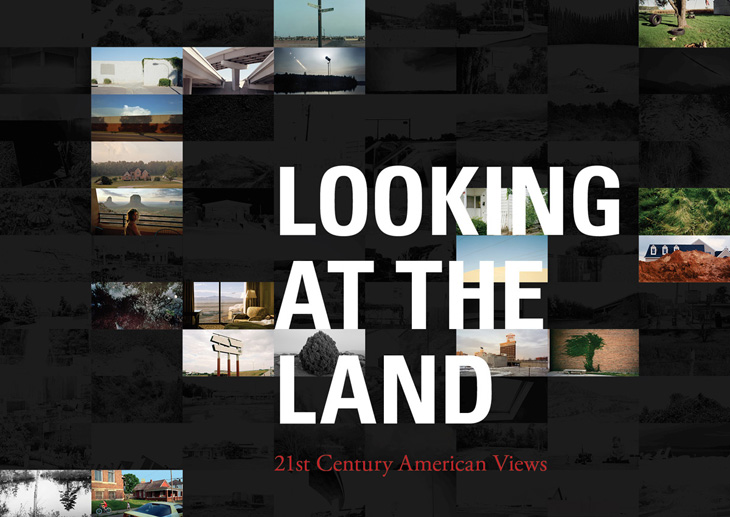 You may remember our conversation with Andy in May when we discussed the concept of Photo 2.0 and the role of Web 2.0 technologies in redefining the field of photography.
You may remember our conversation with Andy in May when we discussed the concept of Photo 2.0 and the role of Web 2.0 technologies in redefining the field of photography.
Andy’s newest success, “Looking at the Land: 21st Century American Views,” is a digital exhibition of 21st Century American Landscape photography. The exhibition, prepared in collaboration with the Museum of Art, Rhode Island School of Design, is a discussion (both in photographs and in interviews) with eighty-eight photographers on the practice and meaning of landscape photo-making in the 21st Century. On the website, Andy discusses the current status of the exhibition, including the presentation of twenty of the photographs in physical form at the FotoWeek DC 2012 festival.
Andy and I again had the chance to discuss the themes of photography and online-presenting, but this time focused on the process of organizing a digital exhibition, his experience with crowdsourcing creativity, and his thoughts on the effects of digital projection on viewing. While my full interview with Andy will be posted here on Technology in the Arts soon, I encourage you to view the online exhibition beforehand (available for viewing below).
[embed]http://vimeo.com/49855891[/embed]
Check back in next two weeks for more of Andy’s insight on the future of photography, digital exhibitions, and crowdsourcing creativity.
A Data Visualization of Art & Money
Looking for a well-worth-it distraction? Check out Art & Money, an animated art auction infographic by Jean Abbiateci. It visualizes metrics for the top 270 most expensive artworks sold in auction between 2008 and 2011.
Methodology: the radius of the bubbles is calculated on the amount of sales. Theses prices do not include the buyer's commission.
Data visualized includes the size of the artwork, the artist's nationality, date created, selling price, etc. The data is then sorted in different categories so viewers can explore the relationship between male and female buyers, a comparison between top-selling work of dead artists and living artists, a look at how the top auction houses compare, etc.
Any surprises? Share with us!
The Meta-Museum: A Work of Art Depicting Museum Visitors Admiring a Work of Art
Before you head off on summer holiday, take a look at the newest addition to the Museum of Fine Art, Boston’s, Arts of the Americas wing. Warren Prosperi’s realist painting, “Museum Epiphany III,” depicts museum visitors amid the 19th-century paintings and sculptures in the Penny and Jeff Vinik Gallery of the Museum.
Those years I spent studying and copying at the MFA, I got to see the life of the museum. There’s different types of people who are always moving through the gallery. At one point I said, “All this vibrant life in the museum is a painting in and of itself.” So I started a group of paintings about the works of art, and the museumgoers, and their relationship to each other. - Warren Prosperi in a Boston Globe interview
“Museum Ephiphany I” and “Museum Ephiphany II” also feature specific locations in the Museum and were purchased by Museum trustee, David Croll. “Museum Epiphany III” will be one in a series of potentially 25 paintings.
What a turn of events when visitors become the subject of the art they view.
(Photo courtesy: David L. Ryan/Globe Staff)
Canal Educatif: Art History Like You've Never Seen Before!
On YouTube, if you unearth past the layers of apocalyptic cats, nyan cats, evil cats, scary cats, and sneaky cats, you’ll find content that can actually educate you! A double rainbow for erudition! We have all heard about the instructional simplicity of Khan Academy and the brilliance of Ted-Ed, but there’s an equally fantastic channel for Art History buffs that truly deserves some viral appreciation: Canal Educatif à la Demande. Canal Educatif (educational channel) is a French co-operative project. Our aim is to produce a unique series of high-quality educational videos and make them available free of charge to young people and adults.
Since 2007, Canal Educatif (CED) has produced investigative-style documentaries on Art History, Economics, and Sciences and Innovation. Tristement, only the Art History section is available in English and it includes documentaries on works by Holbein, Delacroix, Poussin, and Rodin. But it is clear that the quality of these videos far succeeds their quantity! For example, in Delacroix’s Liberty Leading the People, the documentary explores why Delacroix, an aristocrat, would paint the very ideal he opposed and even feared? And why did Rodin leave his iconic sculptural gateway, The Gates of Hell, unfinished? Why was it never cast in bronze? These are just some of the questions answered in the highly informative series of documentaries produced by CED.
http://www.youtube.com/watch?v=yFu3aJgkYkU
The organization has also explored a new avenue in the dissemination of Art History; the Google Art Project. In a YouTube series called Art Sleuth, CED has created short, detective style explorations of some of the gigapixel paintings on the Art Project. In these clever, 10 to 15 minute episodes, the nitty gritties of close observation reveal that in art too, the devil is in the details ; what seems to be a touching portrait of Marie Antoinette and her children, can emerge as thinly veiled attempt at false benevolence and humility. Coincidentally, there are some works in which there is literally (and figuratively), a Devil in the details.
http://www.youtube.com/watch?v=gjcR90M8of4
To cover its production expenses, CED relies on micro-donations made to their website. So if you’d like to learn more about Manet’s A Bar at Folies Bergères, do make a contribution! Here’s hoping that Kickstarter will soon be launched in Europe because CED’s projects (Filmmaking) seem ideal for the crowdfunding platform. In the meantime, there’s a lot of content offered by CED on both YouTube and on its website. You certainly won't miss the repetitive babbling of nyan cats after having watched Manet’s In the Conservatory or Rembrandt’s The Prodigal Son. Let the sleuthing begin!
Beautifying the City through Public Works of Art
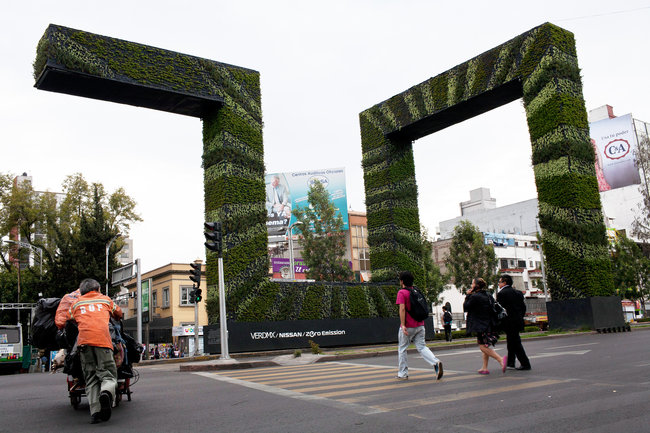 There may be no better way to beautify a city (or most cost effective way, in many aspects) than by using public works of art.
As I have written about before, cities, especially cities that are losing population and/or facing severe budget shortfalls, are turning more and more to public art to revitalize areas and encourage more tourism. And as I wrote about last week, cities are turning more and more to what makes them unique, a significant change in focus from the tried and true method of trying to outdo or outclass your neighbors. Gone are the days (I hope, at least) of cities competing for visitors by building bigger stadiums or concert halls in an attempt to prove that they are, in fact, the most exciting city this world has ever seen.
There may be no better way to beautify a city (or most cost effective way, in many aspects) than by using public works of art.
As I have written about before, cities, especially cities that are losing population and/or facing severe budget shortfalls, are turning more and more to public art to revitalize areas and encourage more tourism. And as I wrote about last week, cities are turning more and more to what makes them unique, a significant change in focus from the tried and true method of trying to outdo or outclass your neighbors. Gone are the days (I hope, at least) of cities competing for visitors by building bigger stadiums or concert halls in an attempt to prove that they are, in fact, the most exciting city this world has ever seen.
In light of all this talk about urban renewal, green spaces, and new works of public art, what are some of the latest and greatest pieces of work on display? A number of outlets, including the New York Times, the Atlantic and others, have recently taken a look at works from across the world, and I have assembled them here for your viewing pleasure!
The New York Times recently took a look at a new project in Mexico City that seeks to provide both aesthetic pleasure and help the environment: a set of three “eco-sculptures” that comprise a sort of urban garden in the city. As you can see in the image above, these arches, comprised of thousands of plants each, are an attempt to beautify the city and help ease pollution in the large metropolis. Installed by a local non-profit, the sculptures are part of an overall effort to help green a city that is not particularly known for having a sustainable reputation; as the New York Times reports, these three sculptures are just a small part of a broader garden movement, and the attention these works of art have received are bound to make the effort that much more noticeable.
Over in Los Angeles, a new public art project has taken a little of bit of nature and transported it, visually at least, to an urban area. Artist Paige Smith has crafted little miniature geodes, crystals that form inside of some rocks, and installed them in unassuming places around the city: inside pipes, brick walls, or even the cracks of a wall. Smith has created little 3D sculptures made of paper to have the appearance of geodes, and the result is a unique little diversion from the normal city wall. She’s up to a dozen installations across the city, and you can see a full map of locations on her website.
(Photo courtesy of Paige Smith)
In St. Louis, public art is being used to help solve a problem: how do theatres make their patrons more efficient? In other words, is there a way to encourage patrons to stay longer and keep themselves busy, instead of just standing around waiting for the show to start?
A piece is going up in the Grand Center neighborhood of St. Louis that is designed to encourage patrons and visitors to stay a while. Titled “A Chromatic Confluence,” it will be a mazelike sculpture made up of about 20,000 feet of different colors of string. The overall structure will be fairly large in size, about 25-feet by 65-feet, and will be lit up at night, as you can see below. Hoping to draw in patrons and foot traffic, it is an attempt to grab people’s attention and give them something to do before the show starts. The piece is the first of a planned series of public art projects in the St. Louis area, in an overall attempt to bring more culture and artistic pieces to the city.
(Photo courtesy of the St. Louis Post-Dispatch)
Overseas, the city of Manila is moving ahead with public art, but is doing so in an attempt to be as environmentally sustainable as possible. Manila has the distinction of being one of the world’s most polluted cities, and attempts have been made in recent years to help cut down on emissions and improve air quality.
Courtesy of the Atlantic, a local Philippine company has created a paint which it claims can help purify the air while being used, and since the discovery, murals have been painted all over the city in attempt to not only beautify areas of the city that been victims of neglect and destruction, but also help the environment as well. The BBC recently filed a report about the paint and the attempt to improve the city through public art.
(Photo courtesy of The Atlantic)
These are just a few of the examples of cities using public art to help improve the aesthetic quality of their cities. Many more projects are underway, popping up in cities all across the United States and the world. What are some of your favorite public works of art in your cities, or perhaps favorites you’ve seen in others? Feel free to comment below!
(Top photo courtesy of the New York Times)
Lessons from the Bronx
By now you may be aware of the Bronx Museum of the Arts' new ticketing initiative. If not, take a look at the Museum's Facebook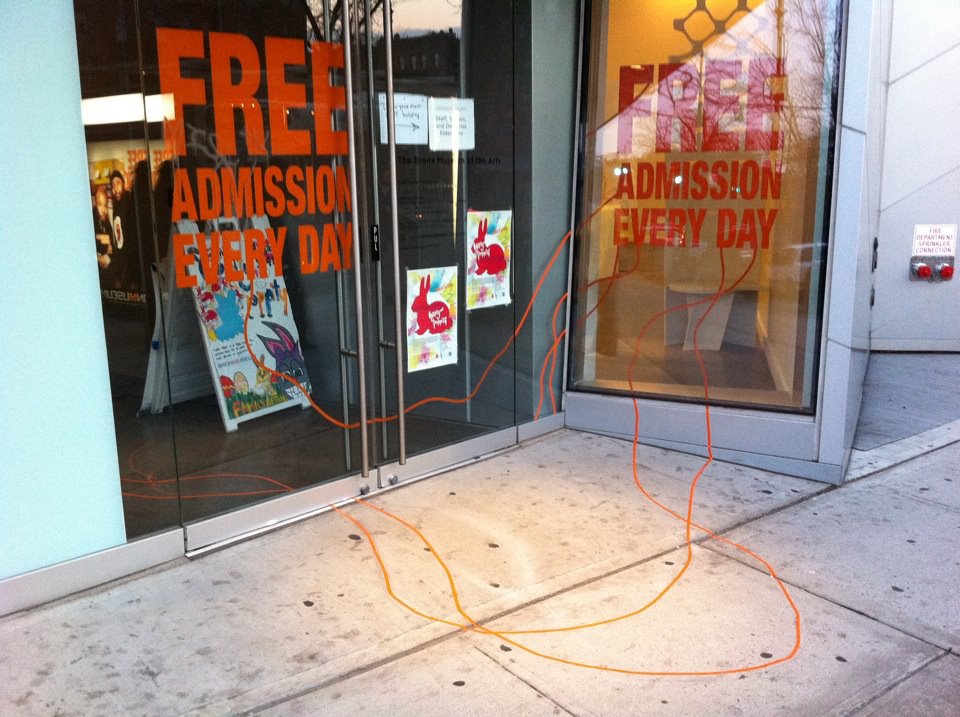 status from March 30th: "Starting today, the Bronx Museum of the Arts will be Free to all. Thursday through Sunday, FREE! First Fridays! FREE. Whether you're 8 or 88, FREE! Getting Here: B/D train to 167th St (Unlike the Museum, the train fare is not free)."
In celebration of its 40th anniversary, the Museum announced just last month it would offer free admission to guests-- this coming at a time when student discounts, twofer deals, good coupons, and gas below $3.99/gallon are at a premium. According to Museum Director, Holly Block,
status from March 30th: "Starting today, the Bronx Museum of the Arts will be Free to all. Thursday through Sunday, FREE! First Fridays! FREE. Whether you're 8 or 88, FREE! Getting Here: B/D train to 167th St (Unlike the Museum, the train fare is not free)."
In celebration of its 40th anniversary, the Museum announced just last month it would offer free admission to guests-- this coming at a time when student discounts, twofer deals, good coupons, and gas below $3.99/gallon are at a premium. According to Museum Director, Holly Block,
With our immediate community being the poorest per capita in the nation, and at a time when many are struggling to pay bills…we don't want anyone to have to use (admission costs) as excuse not to visit us.
It is because of a grant from the New York Community Trust that the museum is able to offer free admission to the public- though the grant only covers admission costs up to 15 months. The Museum is hoping to secure a more permanent funding source to be able to continue to provide free admission to the public after those 15 months.
Not only does this reduce barriers of entry for Bronx residents, New Yorkers, tourists, and artists, but it also benefits the museum community at large. Many museums have implemented similar free admission pilot programs and have reported varying results. It will be interesting to follow up with the Bronx Museum at the conclusion of the 15 month, free admission period to review its attendance numbers and demographics during that time.
While snooping around for more information on the Museum’s new pilot program, I stumbled upon two special offerings at the Museum. How did I NOT know about these programs?!
1) smARTpo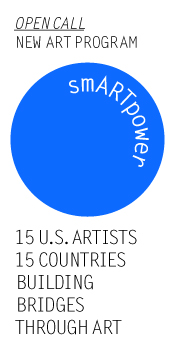 wer: In conjunction with the U.S. Department of State’s Bureau of Education and Cultural Affairs, the Bronx Museum administers this cultural diplomacy program. The program funds and provides travel opportunities for 15 U.S. artists to create and work abroad on a community-based art project. smARTpower supports “the development and implementation of community-based art projects that engage youth and other local residents, including artists. The projects are strongly encouraged to create a tangible legacy of the work accomplished through smARTpower in a variety of visual arts media…” The program is open to professional artists only with U.S. citizenship.
wer: In conjunction with the U.S. Department of State’s Bureau of Education and Cultural Affairs, the Bronx Museum administers this cultural diplomacy program. The program funds and provides travel opportunities for 15 U.S. artists to create and work abroad on a community-based art project. smARTpower supports “the development and implementation of community-based art projects that engage youth and other local residents, including artists. The projects are strongly encouraged to create a tangible legacy of the work accomplished through smARTpower in a variety of visual arts media…” The program is open to professional artists only with U.S. citizenship.
2) Artist in the Marketplace (AIM): Established in 1980, the program seeks to provide “networking opportunities for emerging artists residing in the New York metropolitan area" and to introduce "their work to a greater audience.” Thirty-six selected participants attend weekly seminars led by a faculty of specialists. Topics covered in these sessions “address areas of practical concern to artists including: career management and gallery representation; exhibition and public art opportunities; grant writing, copyright law, and marketing.”
It is a hopeful sign, especially in these financially trying times, when a non-profit arts organization remains so concerned with serving its constituents- accessibility for its local audience, professional advancement for its arts community, and greater cultural understanding in diplomacy efforts.
Rivers of Ice: Exhibitions at MIT Museum and Everest Base Camp
An exhibition at the Mount Everest Base Camp is no ordinary undertaking. The location itself is bound to generate a few shudders. But for an organization named GlacierWorks, no glacier is too remote a location to increase awareness about the potential impact of glacial loss on Asia’s water supply. Incidentally, for those far from the Himalayas but close to Massachusetts, their work is also being exhibited at the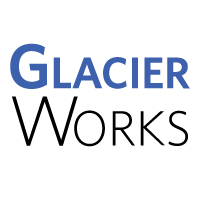 MIT Museum.
GlacierWorks is an organization we have written about in the past because of their unique use of “art, science, and adventure” to document changes in the Himalayan glaciers. Through a process of matched photography, using images by 20th century photographers such as Vittorio Sella and Sir George Mallory, they are able to note the decrease in glacial mass that has taken place during the course of the century. The results are presented in compelling photographic exhibitions that narrate a story of loss in the highest reaches of the Himalayas.
MIT Museum.
GlacierWorks is an organization we have written about in the past because of their unique use of “art, science, and adventure” to document changes in the Himalayan glaciers. Through a process of matched photography, using images by 20th century photographers such as Vittorio Sella and Sir George Mallory, they are able to note the decrease in glacial mass that has taken place during the course of the century. The results are presented in compelling photographic exhibitions that narrate a story of loss in the highest reaches of the Himalayas.
For an exhibition titled, Rivers of Ice: Vanishing Glaciers of the Greater Himalaya, the Everest Base Camp couldn’t be a more appropriate or beautiful location. “Set against the magnificent backdrop of Mount Everest and the Khumbu glacier, Rivers of Ice presents visitors with a chance to admire the vast beauty of the High Himalaya while reflecting upon the profound changes taking place in this seemingly impermeable landscape.”
GlacierWorks stresses how some of the most important rivers in Asia (Indus, Ganges, Yellow, Yangtze etc.) rely on the Himalayan glaciers for “seasonal flow of fresh water”, and any change in that flow can affect millions of people downstream.
“Data collection in this vast and remote region is impossible for all but the most seasoned climbers, and each glacier has unique characteristics that prevent broad generalizations about the region as a whole. Nevertheless, scientists agree that there is a trend of melting beyond what can be expected to occur naturally.”
Since Everest Base Camp is a mountaineering mecca of sorts, Rivers of Ice is sure to affect the daring mountaineers who tread upon the very glaciers exhibited. Yet more importantly, the cause for concern is destined to wind its way down the Himalayas; to India, China, and the international community as a whole. Those with little to no inclination for steep inclines and frosty conditions can keep up with the exhibit via GlacierWorks’ Facebook and Google+ pages. You can also follow the exhibit on their Twitter, where it will be promoted using the hashtag, #icegallery.
If you wish to see their photographs in person but are daunted by the notion of a journey to the base of Mount Everest, you can make a far less taxing visit to the Rivers of Ice exhibit at the MIT Museum. Rivers of Ice seeks to “trigger public dialogue as scientists and policymakers work to better understand the glaciers’ potential impact on the fresh water supply in Asia, and on global environmental issues in general.”
As the MIT Museum explains, the true plight of the Himalayan glaciers has led to a certain degree of controversy in academia. A scientific report earlier this year concluded that the Himalayan glaciers had in effect seen no decrease in ice between 2003 and 2010; the loss of glacial ice had been compensated for by an increase in ice in the caps. Understandably, the behavior of these glaciers confounds climate scientists. Yet they remain a rare, unexplained exception as the study shows that glaciers in Antarctica and Greenland are losing mass at significant rates. Globally, a total of 536 gigatonnes of ice have been lost between 2003 and 2010.
The MIT Museum goes on to say the following:
“As our thinking about Rivers of Ice evolved, we came to realize that the exhibition gives us an ideal platform for opening discussions about climate change, about water resources and, fundamentally, about how science works. Acquiring scientific knowledge is a back-and-forth, trial and error process. As the research continues, we hope for more clarity, but we're prepared for more disagreement about what exactly is happening to the glaciers in the Himalaya.”
GlacierWorks photographs are an excellent opportunity to delve into the conversation about climate change. And even as we wait upon clarity regarding the Himalayan glaciers, the broader trend of glacial loss could not be clearer. It’s easy to forget about climate change when you live under perpetually sunny skies. But a trip to the Himalayan glaciers on GlacierWork’s website or the MIT Museum will definitely give you something to shiver about.









